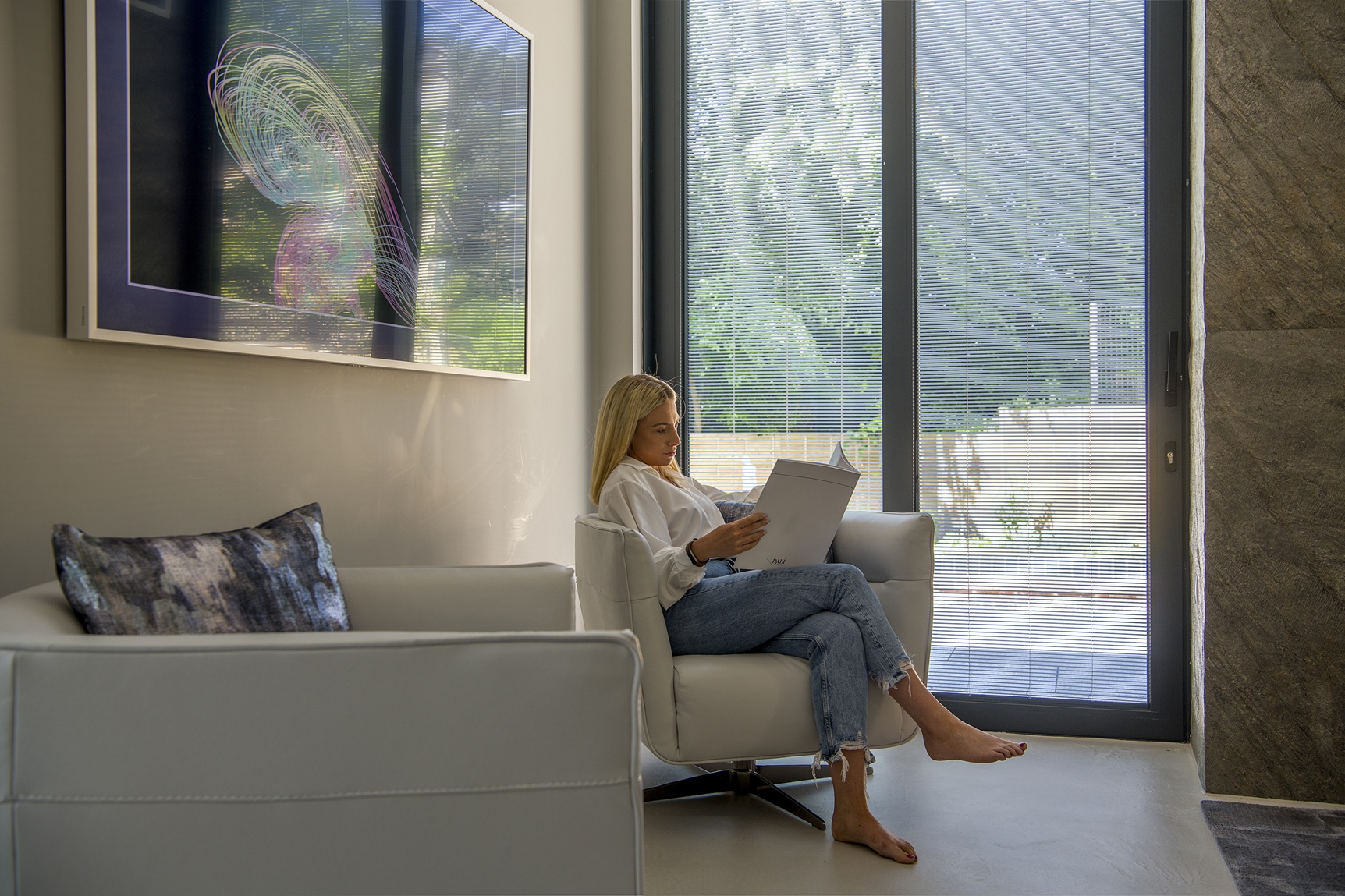What Are Integral Blinds and How Do They Work?
Integral blinds are an innovative window covering solution where the blinds are sealed inside a double or triple glazed glass unit. Unlike traditional blinds or curtains that sit outside the glass, integral blinds are encapsulated between the panes, creating a sleek and maintenance-free option for homes and commercial spaces. Their unique design offers a range of benefits, including improved hygiene, enhanced aesthetics, and better control over light and privacy.

Integral Blinds Example
How Do Integral Blinds Work?
Integral blinds work by being permanently housed within the cavity of an insulated glass unit (IGU), typically in double or triple glazed windows and doors. Because they are sealed inside the glass, they are protected from dust, dirt, and damage, which significantly extends their lifespan. The blinds themselves can be Venetian or pleated in style and are operated via magnetic sliders, cords, or motorised systems depending on the product range.
Manual integral blinds use a magnetic control that is attached to the glass. The magnet on the outside of the unit manipulates a corresponding magnet inside, allowing the user to tilt, raise, or lower the blind with ease. Motorised versions take convenience even further by using electric motors powered by mains electricity, solar panels, or battery packs. These can often be controlled via remote controls, wall switches, or even smart home systems.
Why Choose Integral Blinds Over Traditional Blinds?
There are several compelling reasons to choose integral blinds over traditional external blinds or curtains. First and foremost, their placement between the glass panes means they are completely maintenance-free. There is no need for cleaning, dusting, or untangling cords, which saves both time and effort, especially in busy households or commercial environments.
Integral blinds also offer a streamlined, contemporary appearance that fits perfectly with modern interior design. There are no cords or brackets visible, and no need for extra wall or frame space to accommodate bulky blinds or curtains. This minimalist aesthetic is particularly well-suited to open-plan kitchens, bathrooms, conservatories, and bifold or sliding doors.
Another key benefit is their improved hygiene. In clinical settings, hospitals, or schools, integral blinds help reduce the risk of contamination because they are completely enclosed and cannot collect dust or bacteria. This makes them a popular choice for healthcare environments and anywhere where cleanliness is a priority.
Where Can You Use Integral Blinds?
Integral blinds can be used in almost any application that involves double or triple glazed glass units. This includes uPVC, aluminium, or timber windows, as well as glazed doors, bifold doors, sliding patio doors, French doors, and even internal glass partitions. Because they are factory-fitted within the glass unit itself, they can be integrated into new installations or replacement windows and doors.
In residential settings, integral blinds are often used in kitchens, bathrooms, living rooms, and conservatories where privacy and light control are essential. They are also a stylish and practical choice for garden rooms, orangeries, and home offices. In commercial environments, they are ideal for boardrooms, reception areas, clinics, and offices where a clean and professional appearance is desired.
What Styles and Options Are Available?
Modern integral blinds come in a variety of styles, colours, and control mechanisms to suit different preferences and budgets. Venetian blinds are the most common, offering horizontal slats that tilt to control light and privacy. Pleated blinds, with their soft fabric folds, are another popular option, especially for those looking for a more subtle or textured look.
In terms of operation, options include manual sliders, corded systems, and fully motorised models. Manual magnetic sliders are cost-effective and easy to use, while motorised options offer enhanced comfort and are ideal for hard-to-reach windows. Some motorised systems even integrate with home automation platforms like Alexa or Google Home, allowing voice control or scheduled operation.
Colour choices are broad, with neutral tones like white, grey, and beige remaining popular, but bolder colours are available for those looking to make a statement. Some suppliers also offer solar-controlled glass or low-emissivity coatings to further improve energy efficiency.
Benefits of Integral Blinds
Integral blinds offer several benefits that make them a superior alternative to traditional blinds and curtains:
- No cleaning required: The sealed unit keeps blinds dust-free and spotless.
- Sleek, minimalist appearance: Enhances modern interiors without clutter.
- Child and pet safe: No external cords or choking hazards.
- Long-lasting: Protected from damage and wear, they outlast conventional blinds.
- Improved hygiene: Ideal for hospitals, clinics, and schools.
- Energy efficiency: Help control solar gain and retain heat in winter.
Are There Any Drawbacks?
While integral blinds offer many advantages, there are a few considerations to keep in mind. First, they are generally more expensive upfront than external blinds due to the need for specialised glass units and manufacturing. However, their durability and maintenance-free design often offset the initial cost over time.
Second, because the blinds are sealed within the glass, they cannot be replaced independently. If a fault occurs or the mechanism breaks down, the entire glazed unit may need to be replaced. This is













Great post! Glazing is such an important aspect of both aesthetics and energy efficiency in modern buildings. It’s amazing how the right glass choices can completely transform a space while also improving insulation and reducing noise. Thanks for sharing!